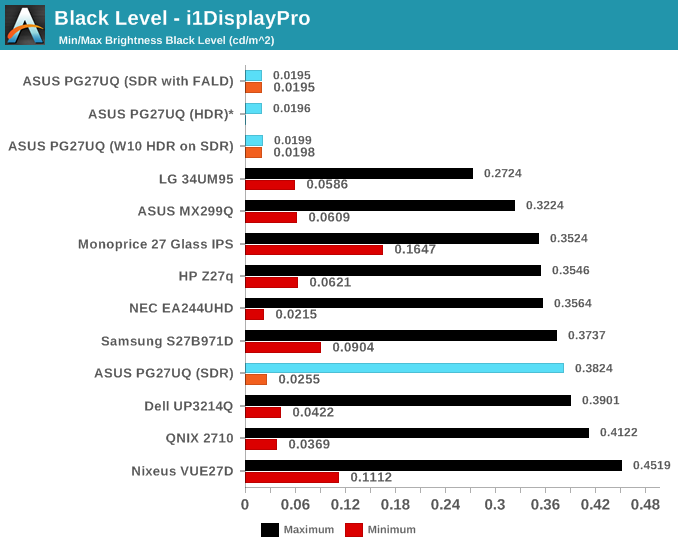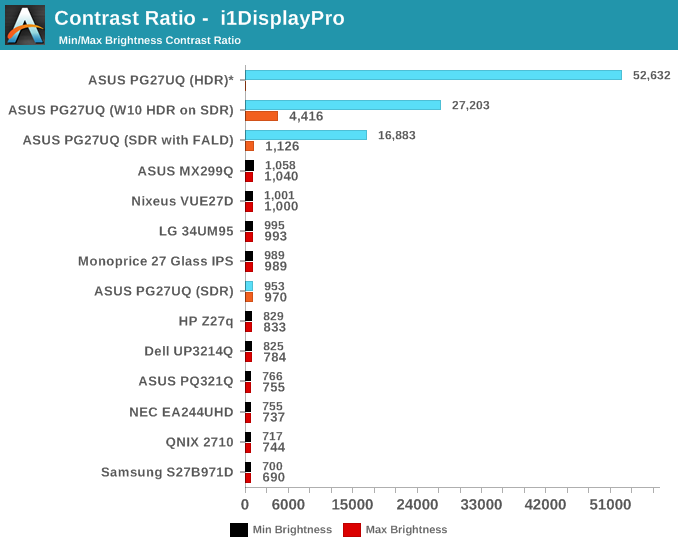The Asus ROG Swift PG27UQ G-SYNC HDR Monitor Review: Gaming With All The Bells and Whistles
by Nate Oh on October 2, 2018 10:00 AM EST- Posted in
- Monitors
- Displays
- Asus
- NVIDIA
- G-Sync
- PG27UQ
- ROG Swift PG27UQ
- G-Sync HDR
Brightness and Contrast
Going straight into the brightness and contrast metrics, we know HDR's calling card is to permit those bright whites and dark blacks. For DisplayHDR 1000, and UHD Premium, 1000 nits (the common non-SI term for cd/m2) is the requirement. So for brightness of white levels, it's no surprise that in HDR mode the PG27UQ reaches that coveted mark.
Outside of HDR, brightness is also useful in gauging visibility/usability in conditions of bright and direct ambient light, i.e. outdoors. For moderately lit indoor use, the typical 200 to 300 nit range of desktop monitors is more than sufficient. In terms of factory defaults, the PG27UQ is set at 80 for brightness, which is around 266 nits. 1000 nits is much too bright for day-to-day usage, as is 500 nits.

*In HDR mode, there is an adjustable 'reference white' setting, defaulted at 80 nits, instead of a brightness setting. At that default setting, the PG27UQ displayed the HDR test pattern at 1032 nits.
Because HDR has a static 'reference white' level instead of brightness, there isn't really an equivalent to minimum brightness white level as it isn't utilized in the same way; for the PG27UQ, reference white can be set between 20 to 300 nits.
Otherwise, enabling the Windows 10 'HDR and Wide Color Gamut' mode puts the monitor into its HDR mode; additionally, that Windows 10 setting provides a brightness slider governing SDR content while in HDR mode. So at 100% SDR brightness, the display pushes past 500 nits. For users, it works nicely to avoid SDR dimness when HDR is enabled, and also providing the option to boost up to much higher brightness if desired.

*Represents black levels corresponding to the default 'reference white' setting of 80 nits.
IPS-type panels are often known for their 'backlight bleed' and so relatively higher black levels. Without its local dimming capability, the PG27UQ isn't much of an exception. Enabling variable backlighting (FALD) in the OSD brings the black levels to HDR tier performance, and can be enabled on SDR mode at the cost of maximum brightness white levels.

*Contrast ratios calculated from default reference white of 80 nits
The good range between bright whites and dark blacks translate into high contrast ratios for the PG27UQ. While we don't have any other HDR monitors for comparison, the contrast ratios are really in their own class, especially as only HDR content will take advantage of the brightness and be (properly) displayed. Otherwise, in pure SDR mode, the PG27UQ resembles a solid IPS-type SDR monitor. Just enabling the direct LED backlighting in SDR mode improves contrasts considerably on the strength of its black levels.










91 Comments
View All Comments
FreckledTrout - Tuesday, October 2, 2018 - link
AUO have stated it lands this fall so should be very soon. They made it sound like they will have a shipping monitor by the end of 2018 albeit who really knows but im sure its under 1 year away at this point.Can Google: "AUO Expects to Launch Mini LED Gaming Monitor in 2H18"
imaheadcase - Wednesday, October 3, 2018 - link
Don't keep hopes hope, remember this monitor in this very review was delayed 6+ monthsLolimaster - Tuesday, October 2, 2018 - link
384 zones is just CRAP, you only find that number of zones on low end cheapo TV's with FALD just o be a bit more "premium". For that price is should have 1000 AT LEAST.Seems we will need to wait for LCD with minileds to actually start seeing monitors with 5000+zones.
know of fence - Tuesday, October 2, 2018 - link
Consoles started to push that 4K / HDR nonsense and now the monopoly provides a monitor to match for the more money than sense crowd. The obscure but sensible strobing backlight / ULMB got sacrificed for the blasted buzzwords and Gsync. Is it because the panel is barely fast enough for Gsync or is it a general shift in direction, doubling down on proprietary G-stink and the ridiculously superfluous 4K native. Is it because with failing VR, high frame rates are off the table completely?Is there any mention on how 1920x1080 looks on that monitor (too bad), because the pixel density is decidedly useless and non standard. But scaled down to half it could be 81.5 ppi and this thing can actually be used to read text.
godrilla - Tuesday, October 2, 2018 - link
$1799 at micr1 fyi!godrilla - Tuesday, October 2, 2018 - link
Microcenter*Hectandan - Tuesday, October 2, 2018 - link
"the most desired and visible aspects of modern gaming monitors: ultra high resolution (4K)"No it's not. At least on Windows where UI scaling still sucks. At least on "slow" graphics card like 2080 Ti where 4K doesn't run 144fps. And 4K monitors can't do 1440p natively, so a huge deal breaker.
Zan Lynx - Wednesday, October 3, 2018 - link
If you had a graphics card that could always run 144 Hz then you would have no need for GSync.imaheadcase - Wednesday, October 3, 2018 - link
Why would you care about scaling for gaming? Besides, plenty of 3rd party apps to correct windows bullshit.Hectandan - Thursday, October 4, 2018 - link
No I don't care about scaling in games, but I do care about 144fps in games. Only possible in 4K with SLI 2080 Ti and good game SLI support. Plenty of games don't.Also plenty of 3rd party apps not correcting Windows bullshit, and I gain no extra working space if I do scale.
Simply too many downsides and too little benefit.